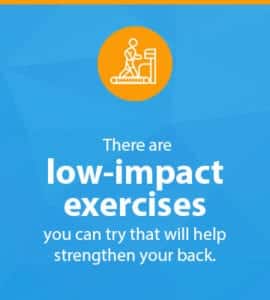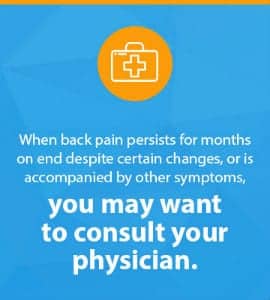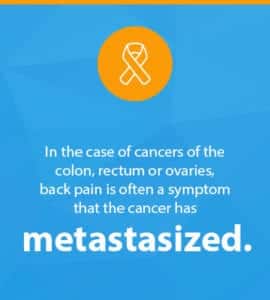It’s something that keeps you up at night, makes daily activities more difficult and slows down your life. While you’re going through times of intense back pain, you might feel like you’re alone. This is hardly the case — you’re one of a huge majority, according to the Chicago Tribune, which reports 80 percent of adults have back pain that is severe enough to seek medical attention — so much so that it is one of the most common complaints cited by people going into hospital emergency rooms.
When you don’t know why you’re experiencing serious back pain, that pain may be compounded by fear. Before you let your fears run away with you, let’s look at some of the common causes of back pain. They are:
- Muscle strain
- Ill-fitting shoes
- Wearing the wrong kinds of shoes
- Being overweight or obese
- Weak back muscles
- Poor posture
- Wearing an unsupportive bra
- Overexertion
- Your mattress
- Depression
- Purse or backpack
In other words, there could be many non-alarming issues causing your back pain and quite a few simple fixes to help you resolve it. In addition to these, aging, smoking, poor physical fitness and genetics may be the source of your back pain, but there are ways to reduce many of the common causes of back pain.

Reduce Your Risks of Back Pain from Common Causes
Severe back pain is no laughing matter. It not only hurts, but it can affect your quality of life by limiting your ability to participate in the fun activities going on around you.
You can address many of the common causes of back pain by following the recommendations listed below.

- Muscle Strain. When it comes to muscle strain, prevention is the best cure. Learn to bend and lift properly. Stretch and warm up correctly before beginning any strenuous workout. Consider yoga and other exercises designed to strengthen your core. Consult your physician before engaging in any exercise program or regimen whether or not you’re currently experiencing back pain.For pain relief in the aftermath of a muscle strain, consider cold compresses, massage therapy and over the counter muscle creams and pain remedies.
- Shoe-Related Back Pain. Whether your back pain is the result of shoes that do not properly fit or the result of wearing the wrong kinds of shoes, there are things you can do to help reduce your back pain.First, exchange shoes that do not fit properly for shoes that have been professionally fit for your feet. These shoes may cost more, but you’ll save money on over-the-counter and other remedies for back pain and hurt less too. Shoe orthotics, which may be more affordable, might work for you, too.Second, wear shoes that offer proper arch support and ditch the stilettos. At the very least, limit your wearing of these types of shoes.
- Weight-Related Back Pain. Back pain brought on by weight is one you must address slowly over time. Exercise efforts may have been thwarted by the pain you’re experiencing, but the reward of taking off those pounds and inches is a life less disrupted by pain. An added benefit is that you may see overall health improvements.
- Weak Back Muscles. This is another problem that may take a little time to correct. Fortunately, there are low-impact exercises you can do to strengthen your back so that your body can do more before feeling the undue back strain and corresponding pain. Like all exercise, first consult your physician to ensure you don’t have restrictions on certain activities.
- Poor Posture. Correcting your posture, both on-the-job and outside of the office, is one of the best gifts you can give yourself. There are many posture correcting exercises you could consider, posture correcting garments and electronic devices that can alert you when you begin to slouch so that you are conscious of it and correct your posture.
- Wearing an Unsupportive bra. Proper support in a bra is especially important for women. Consider going for a professional bra fitting at least once, if not every time you buy a bra — bodies change, and a proper fitting can account for those changes. Avoid wearing a bra that offers little support or is beginning to show signs of wear and age. These recommendations are especially essential for full-busted women.
- Overexertion. Whether you’re exerting yourself in sports, at work or while weeding your flower beds, the back pain that results can put a wrinkle in your plans for the day or a weekend. Don’t overdo it. Take frequent breaks. Bend at the knees rather than the back. Warm up your muscles properly before exerting yourself. These things can help you avoid back pain that is so common from overexertion.
- Your Mattress. There is no one-size-fits-all solution to the problem of a saggy, unsupportive mattress. Your needs will be different according to your personal preferences and how you sleep. If you sleep on your back, for instance, you’ll want a firm and supportive mattress to replace your existing one.Natural latex mattresses are excellent choices. If you sleep on your side, consider looking for the support a latex mattress provides through a layer of comfort, like Talalay latex foam, so various pressure points don’t become sore overnight.
- Depression. Most people think of depression as being the result of long-term or chronic back pain. New evidence suggests that depression might be a potential cause of back pain.Spine Health reports about a study conducted of male veterans suffering from depression and chronic pain. The results revealed 42 percent of the patients studied experienced symptoms of depression before the onset of their pain compared to 58 percent who experienced pain after experiencing depression.
- Backpacks. Heavy bags carried on your shoulders or fitting improperly across your back can cause significant pain. WebMD states that among middle school students aged 11 to 15 who participated in a Riverside, California study, 64 percent reported having back pain at some time. Of that 64 percent, 90 percent reported the pain was either bad or very bad.Lighten the burden your children carrying on their shoulders and choose bags that end above the waist and have belts. Also, make sure the straps are snug and that your children wear their backpacks on both shoulders.

- Purses. Women tend to carry a lot in their handbags. The bigger the bag is, the more items you carry around with you and the heavier the bag becomes. It makes sense since everyone is always handing stuff to mom to hold for them, but you need to ditch the big bag for something better for your body.The lighter the load you carry on your shoulders — and the more evenly you distribute the weight you are carrying — the better it will be for your back and body.
If you suspect any of these potential causes of back pain, see your physician to confirm your condition and begin making changes that will relieve your pain quickly and effectively. Consider regular checkups with your doctor to look for signs and symptoms of conditions that could be underlying causes of back pain. Early treatment can mean less suffering down the road.
While not all back pain is preventable, there is a fair amount of it that is. Avoid things that aggravate or strain your back, practice better posture habits, lift objects safely and be mindful of things like vibrations and repetitive motions in the workplace that could lead to back injuries. The more aware you become of the potential for injury and damage to your back, the better able you will be to guard against it.
Act now to make changes in your lifestyle, diet, fitness routine and health habits that can spare you a lifetime of pain as you age. Be mindful of your posture, embrace back strengthening exercises, stretch properly and thoroughly before engaging in any exercise and choose furniture — like mattresses, sofas and chairs, that offer full support for your back while you sit, sleep, drive and work.

When Is Back Pain Serious?
For the most part, back pain from the conditions mentioned above should go away or lessen once certain lifestyle adjustments and other changes are made. It’s when back pain persists for months on end despite targeted changes or is accompanied by other symptoms. If back pain persists, and is accompanies by the following symptoms, talk with your physician:
- Fever and chills
- Incontinence
- Loss of bowel function or bladder control
- Severe stomach pain with back pain
- Back pain that worsens at night
- Progressive weakness in legs
- Pain that worsens when walking uphill
- Unexplained weight loss
- Difficulty with urination or bowel movements
- Severe, continuous abdominal pain
To answer the question, “Can lower back pain be serious?” The answer is absolutely. It can be a symptom of other underlying conditions or causes that could pose a very genuine risk to your health. That is why it is always advisable to consult your physician or an orthopedic specialist as soon as possible if you’re experiencing any of the symptoms listed above in conjunction with severe back pain.
Low back pain is rarely related to severe underlying conditions, according to the National Institute of Neurological Disorders and Stroke Fact Sheet on Low Back Pain, but it’s better to be cautious and rule out the potential for more serious conditions.
Use our online back pain symptom checker, which makes for a good starting point for a conversation with our NJ Spine & Orthopedic doctor. The online condition checker tool won’t give you a final diagnosis, but getting an idea about the source of your back pain is the initial step toward finding the right treatment option for your back pain.

Severe Back Pain Causes
If you’re suffering from severe back problems, you may find yourself asking, “Why do I have severe back pain?” It could be a broad range of reasons that vary in severity and seriousness. These are a few potential causes of severe back pain that may require medical intervention to correct, and a few of them include:
- Sprains
- Traumatic injuries
- Disc degeneration
- Herniated discs
- Ruptured discs
- Radiculopathy
- Sciatica
- Spondylolisthesis
- Spinal stenosis
- Skeletal irregularities
- Tumors
- Infections
- Kidney stones
- Inflammatory diseases
- Osteoporosis
- Endometriosis
- Fibromyalgia
These are only a few possible answers for what is going on with your back. See your doctor for confirmation of your condition and to seek treatment.

There are other conditions that persistent back pain could indicate, including certain types of cancer, like:
- Pancreatic Cancer
- Colon Cancer
- Rectal Cancer
- Ovarian Cancer
In the case of cancers of the colon, rectum or ovaries, back pain is often a symptom that the cancer has metastasized and is spreading to other areas of the body, according to the American Cancer Society, so it should not be taken lightly.
Though back pain is an unlikely precursor to a serious illness, if you’ve tried making short-term changes mentioned above without receiving relief from your pain, talk to your doctor. Your doctor may be able to rule out some issues quickly, but other times additional testing may be required to make a definitive diagnosis and treatments will vary greatly from one condition to the next.
Potential Treatments for Serious Back Pain
Some people hold off on seeking treatment for fear that the only option available is surgery. While surgery for back pain is sometimes necessary, it isn’t always. There are many other avenues to explore before surgery becomes a necessity, like:
- Physical therapy
- Medication therapy
- Steroid injections
- Hot and cold therapy
- Different Activity
- Strengthening exercises
- Spinal manipulation
- Acupuncture
- Nerve block therapies
- TENS Units (transcutaneous electrical nerve stimulation for pain management)
With the exceptions of physical therapy, strengthening exercises and spinal manipulation, these treatments address the back pain itself but they may not eliminate the source of the pain. When back pain is the symptom of other conditions, those must be treated to relieve the pain you’re feeling. In some of these cases, surgery is a viable option to consider.

Surgical Options for Back Pain

Some surgeries are more effective against specific types of damage than others. You will need to work with your doctor to determine which surgery option is the right choice for you. Below are some of the options your physician may recommend.
- 3D Image-Guided Spine Surgery. The world of back surgery has changed thanks to the technology behind this surgery. It uses the combination of surgical imaging and navigation technologies to assist your surgeon with accuracy and visualization before your procedure while performing your surgery by providing a real-time view of your anatomy in vivid detail with the aid of surgical planning software.
- Spinal Fusion. The most common procedure to treat significant back pain is spinal fusion, which joins vertebrae together. It limits the motion between the vertebrae but should not limit your activities. If you smoke, you will face a greater risk that the bones will not fuse completely, perhaps necessitating another surgery to fix the problem, though it is a slight risk in all spinal fusions.
- Minimally Invasive Spine Surgery. These two words, minimally invasive, are probably music to your ears as you consider your surgical options. For this procedure, a smaller incision is required, which means a smaller scar, less blood loss and a shorter hospital stay. You’ll rely on less pain medication during recovery.While the procedure is minimally invasive, there are still risks associated with the surgery, and it is not the best option for all conditions or all candidates. Work with your doctor to decide if this is a viable option for you.
- Balloon Kyphoplasty or Vertebroplasty for Spinal Fractures. While these are two different procedures, each one offers a similar result — the relief of pain associated with compression fractures of your vertebrae. They also follow similar paths to get there.The point of each surgery is to bolster fractured bone with the addition of material into the vertebra that provides structure and stability. Kyphoplasty involves one additional step of inflating the compressed vertebra with a balloon-like device before the injection. The device is designed to restore height to the crumbled vertebra so that deformity does not occur.
- Decompression of a Pinched Nerve. There are a few options available when it comes to decompression for pinched nerves. The three most common types of surgery to accomplish this important, pain-relieving task, include:
- Discectomy. A discectomy removes all or part of a herniated disc or one causing pain by compressing a nerve. There are typically two types of discectomies: percutaneous and microsurgical.
- Laminectomy. The lamina is the backside of your spinal column that provides a “roof” over the spinal cord. The laminectomy removes the lamina and any spurs that have formed along the spine to cause you pain.
- Laminotomy or Foraminotomy. This procedure doesn’t remove the lamina but instead shaves it to offer relief to the pinched nerve.
There are other options to consider that are less common that may appeal to your physician for a variety of reasons. They include procedures like artificial disc replacement, plasma disc decompression (PDD), intradiscal electrothermal therapy (IDET) and radiofrequency denervation.
Regardless of how you feel about the back pain you’re living with, surgery is not always the best option and — in most cases — should be reserved as a last resort. Surgery is often recommended as an option only after you’ve exhausted other treatments that include things like lifestyle changes, medications, physical therapy, manual manipulation and more.

Find Out If Your Back Pain Is Serious
Remember, finding out the source of your back pain is the first step in learning whether it’s serious. Start by using our online condition check tool. This tool begins the process of finding answers for your back pain. Get your pain diagnosed swiftly and efficiently so you can be treated properly and see your quality of life improvements.
When you experience extreme back pain, make it a priority to make an appointment here at NJ Spine & Orthopedic so you can begin the healing process — or at the very least get answers — fast.

